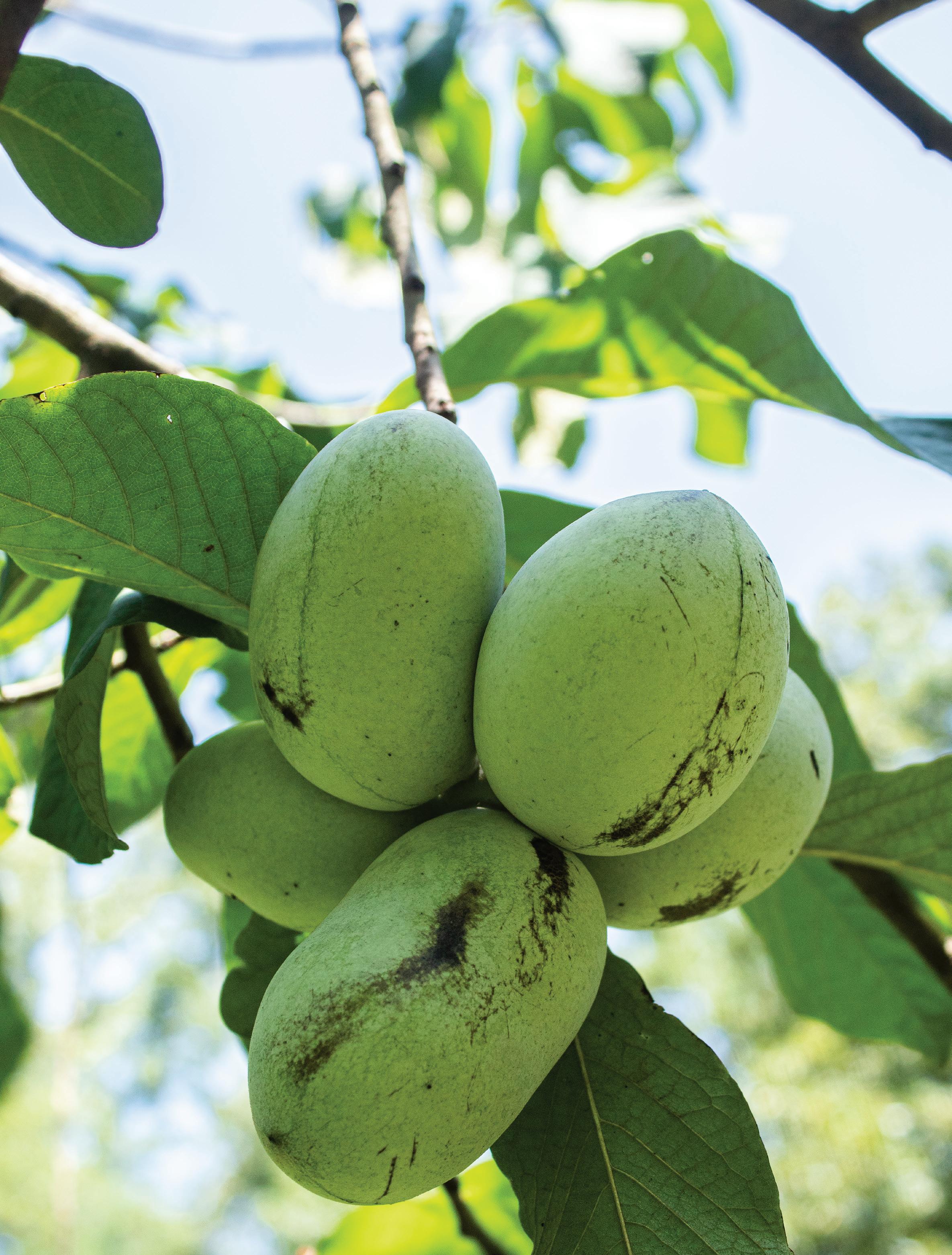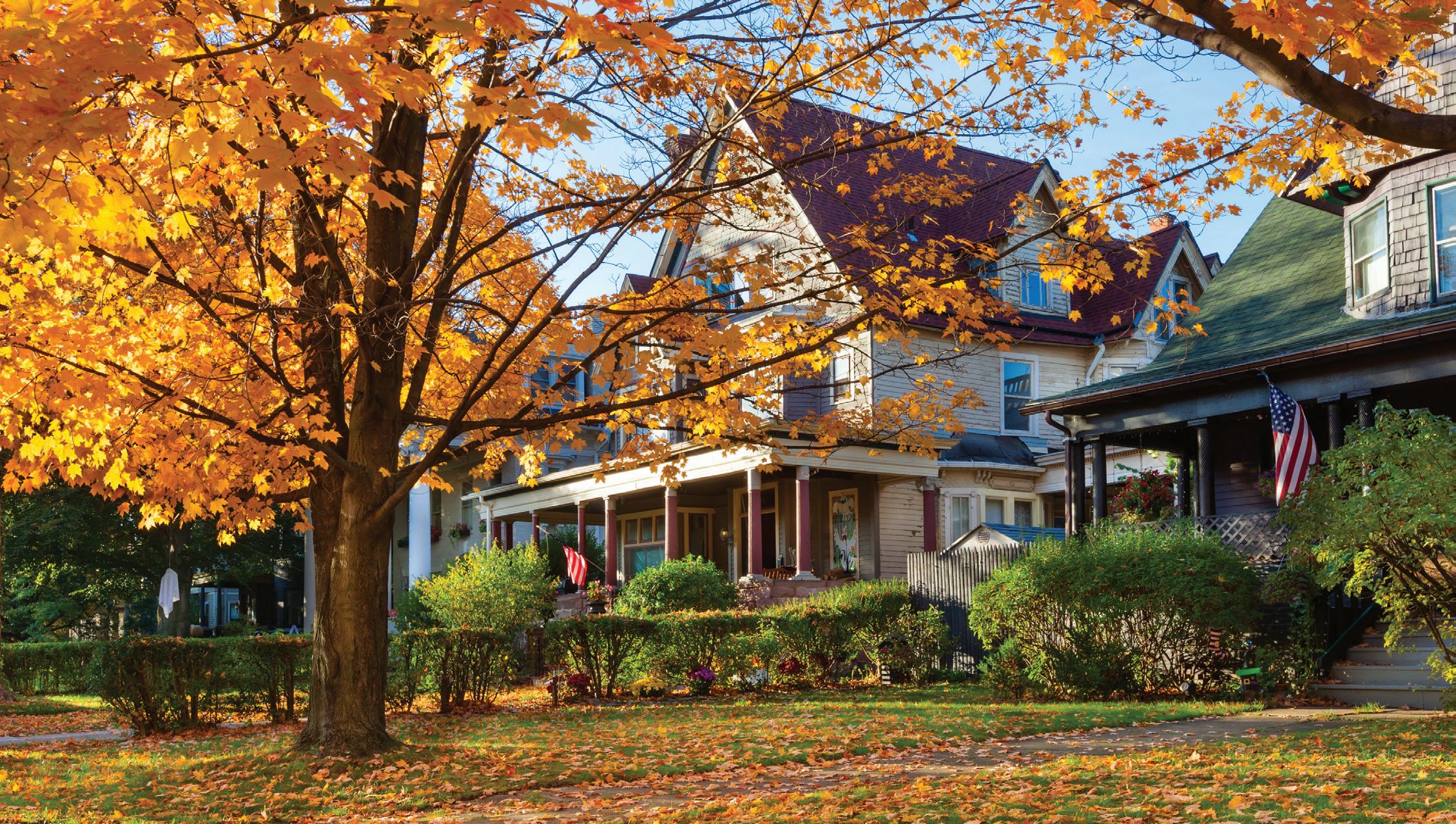
6 minute read
Fruit’s flavors are worthy of folklore
Exotic Virginia
Pawpaw’s tropical flavors rooted in American landscape
Advertisement
ARTICLE AND PHOTOS BY NICOLE ZEMA
That thumping you hear in late summer down by the creek may evoke images of Bigfoot, but the sound likely emits from another obscure and legendary indigenous species—heavy pawpaw fruits falling to the ground.
Pawpaw trees drop their large, ripened fruits from late July to September in low-lying areas in the Eastern U.S. and in Nebraska and Canada. Soft and highly perishable, a pawpaw delivers a fleeting taste of tropical flavors that bewilder the palate.
Horticulturists are exploring the economic potential of pawpaw farming for small producers focused on locally grown food.
“The taste is complex, so it’s easy to love it, or dislike it,” said Dr. Reza Rafie, a horticulture professor and Virginia Cooperative Extension specialist at Virginia State University. “It’s creamy and flavorful. Most relatives of this fruit are tropical.”
The fruit’s custard-like texture packs banana, mango and pineapple flavors worthy of folklore. Pawpaws are nutritious too—low-calorie and loaded with vitamin C, magnesium, iron, copper, manganese and several essential amino acids.
The pawpaw is under consideration for Virginia’s state fruit, but you won’t find them at farm stands or on grocery shelves.
“They’re extremely perishable,” Rafie said, standing in the shade of pawpaw trees growing in his Chesterfield County yard. “They last only two or three days, and they fall apart. That’s

why you can’t commercially ship them on a truck from one place to another. And they’re only available for a short period of time. But with the locally grown food movement, people have become interested in that local taste and flavor.”
Rafie said the fruit’s pulp is processed into value-added products like ice cream, beer, wine, breads, jellies and jams.
“A lot of people will pass by pawpaw trees and never pay attention, but others go pawpaw hunting,” he continued. Naturally occurring pawpaw trees are often small because they grow in shaded areas with rich soil near water sources.
“But once you get them established
Inside a pawpaw’s leathery shell is a creamy, custard-like flesh with tropical flavors. Older varieties have more seeds than flesh.

in sunlight and open space, it’s a different story,” Rafie said. “There are a lot of new varieties of pawpaw coming on.”
A pawpaw variety trial is underway at VSU’s Randolph Farm. Researchers intend to collect data comparing different varieties’ flavor, texture, size and post-harvest perishability.
“Particularly the older varieties have a lot of seeds with not that much flesh,” Rafie explained. “But newer varieties have smaller seeds and more flesh. We’ll establish the value of each variety and let growers decide what they want to do.”
For more information on pawpaws, contact Rafie at 804-712-4600 or arafie@vsu.edu.
Make plans to prevent problems with tree roots
BY ALICE KEMP N othing turns a front yard into a verdant oasis like a mature tree that shades beautiful flower beds.
But over time, you may notice a house’s water pressure is waning. Or a clogged drain won’t clear no matter how many treatments are applied.
Consulting a plumber may reveal the culprit—roots from the stately tree have found their way into the pipes.

A tree’s nature
“Roots will grow where there is available air and water,” said Joel Koci, a Virginia Cooperative Extension agriculture and natural resources specialist and a Board Certified Master Arborist.
Many times, Koci said, a tree can become a detriment because of the soil. If it doesn’t get nutrients it needs from the soil, its root system will expand, and could end up in a leaky water pipe.
Horticulturalist Mark Viette in Augusta County has seen this firsthand with a weeping willow. “I’ve got a 4-inchdiameter root that grew all the way into a pipe for 40 feet.”
While roots can occasionally grow into pipes, direct root damage to a house’s foundation is rare. Signs of potential damage include buckling or cracks in the foundation floors or walls and uneven window or door frames. Further investigation is needed to determine if a tree is at fault.
“There are a few trees that are pretty aggressive,” Viette said. “But usually it’s a poorly constructed foundation that succumbs to root damage.”
To keep soil nutrient-rich and minimize potential root issues, Koci and Viette suggest mulching. “When you properly mulch, the mulch will encourage soil microbes, which will fertilize the soil and make it more congenial for roots,” Koci said. “The roots will grow under the mulch and not go out away from it.”
Root guards or barriers placed in the ground near a foundation also can prevent roots from growing where they aren’t wanted.
Plan and choose wisely
You can hear the passion in Koci’s voice when he talks about trees. He emphasized the best way to prevent issues with tree roots, or trees in general, is to plan before planting.
“The aesthetics are what people go for first,” Koci said. “That should be the last thing that comes to mind.”
When considering a tree, consider the soil type, moisture, lighting, temperature, room for growth and the tree’s potential size. Choosing a tree ideal for the conditions where it’s being planted can help mitigate issues down the road.
Koci suggested prioritizing native trees, as they typically require less maintenance than introduced trees. Some maple varieties can make a striking addition to a landscape and have little root conflicts.
Also the American dogwood and Cleveland pear are beautiful flowering options.
“They’re great to use,” Viette said about the dogwood. “They don’t get too big.”
Generally, Koci said, “narrow canopy trees have a narrow root spread, and cause little root interference.”
As far as trees to avoid, both Koci and Viette said planting a weeping willow or silver maple near a house is risky. Brittle and prone to falling, they have sprawling, fast-growing root systems.
insurance
How to determine if homeowner insurance covers root damage

Coverage for homes damaged by tree roots varies based on the insurance provider and circumstances surrounding the damage.
Lisa Whitus, underwriting manager for Virginia Farm Bureau Mutual Insurance Co., said that, in general, damage caused by pressure of a naturally-growing root to the foundation, sidewalks, or other property is not covered under a homeowner policy. However, if wind blew a tree over, causing the roots to pull up and damage property, that would likely be covered by a homeowner policy, she said.
If roots encroached on a water or sewer line and caused sewer or drain backups inside the dwelling, coverage would be provided for the resulting water damage if the homeowner has water backup coverage. Otherwise, root damage to underground piping without direct damage to the structure isn’t covered.
Whitus recommended policyholders contact their insurance agent for details.

Tree planting formula
Mark Viette has a formula he uses for planning where to plant a tree.
He said to consider the whole width the tree will grow to the outer circumference of its branches, which is called the dripline. Divide that measurement in half, and add 10 feet.
For example, if a tree’s dripline measures 50 feet, it should be planted 35 feet from the house.




